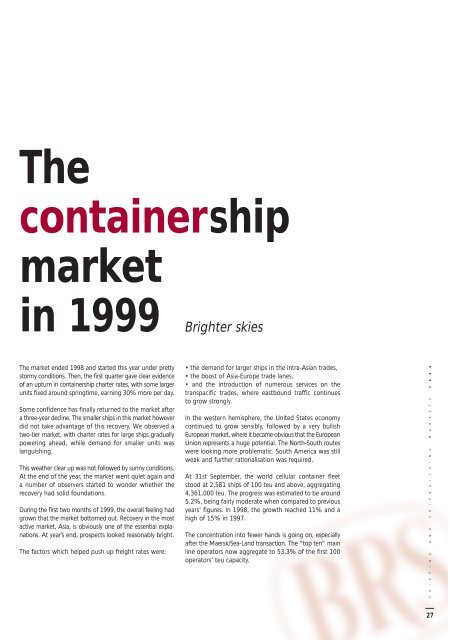Create successful ePaper yourself
Turn your PDF publications into a flip-book with our unique Google optimized e-Paper software.
The<br />
containership<br />
market<br />
in 1999 Brighter skies<br />
The market ended 1998 and started this year under pretty<br />
s<strong>to</strong>rmy conditions. Then, the first quarter gave clear evidence<br />
of an upturn in containership charter rates, with some larger<br />
units fixed around springtime, earning 30% more per day.<br />
Some confidence has finally returned <strong>to</strong> the market after<br />
a three-year decline. The smaller ships in this market however<br />
did not take advantage of this recovery. We observed a<br />
two-tier market, with charter rates for large ships gradually<br />
powering ahead, while demand for smaller units was<br />
languishing.<br />
This weather clear up was not followed by sunny conditions.<br />
At the end of the year, the market went quiet again and<br />
a number of observers started <strong>to</strong> wonder whether the<br />
recovery had solid foundations.<br />
During the first two months of 1999, the overall feeling had<br />
grown that the market bot<strong>to</strong>med out. Recovery in the most<br />
active market, Asia, is obviously one of the essential explanations.<br />
At year’s end, prospects looked reasonably bright.<br />
The fac<strong>to</strong>rs which helped push up freight rates were:<br />
• the demand for larger ships in the intra-Asian trades,<br />
• the boost of Asia-Europe trade lanes,<br />
• and the introduction of numerous services on the<br />
transpacific trades, where eastbound traffic continues<br />
<strong>to</strong> grow strongly.<br />
In the western hemisphere, the United States economy<br />
continued <strong>to</strong> grow sensibly, followed by a very bullish<br />
European market, where it became obvious that the European<br />
Union represents a huge potential. The North-South routes<br />
were looking more problematic. South America was still<br />
weak and further rationalisation was required.<br />
At 31st September, the world cellular container fleet<br />
s<strong>to</strong>od at 2,581 ships of 100 teu and above, aggregating<br />
4,361,000 teu. The progress was estimated <strong>to</strong> be around<br />
5.2%, being fairly moderate when compared <strong>to</strong> previous<br />
years' figures. In 1998, the growth reached 11% and a<br />
high of 15% in 1997.<br />
The concentration in<strong>to</strong> fewer hands is going on, especially<br />
after the Maersk/Sea-Land transaction. The "<strong>to</strong>p ten" main<br />
line opera<strong>to</strong>rs now aggregate <strong>to</strong> 53.3% of the first 100<br />
opera<strong>to</strong>rs’ teu capacity.<br />
S H I P P I N G A N D S H I P B U I L D I N G M A R K E T S 2 0 0 0<br />
27


